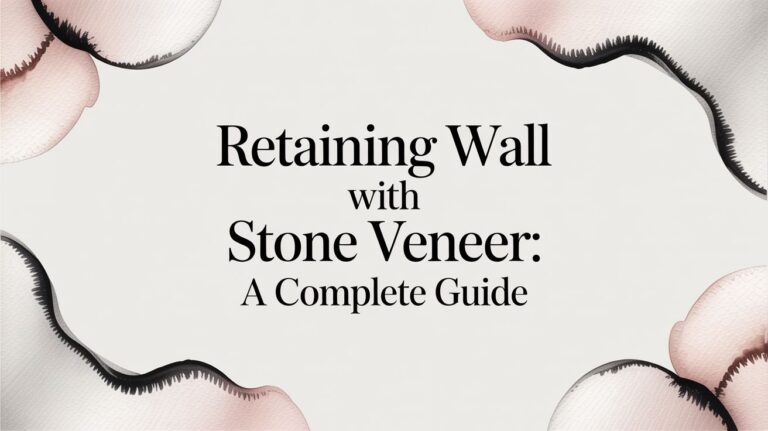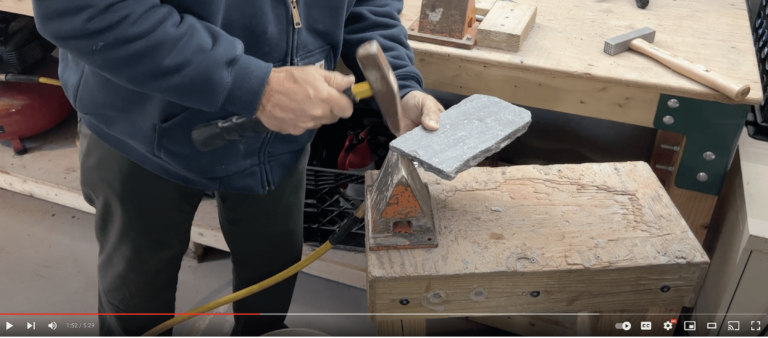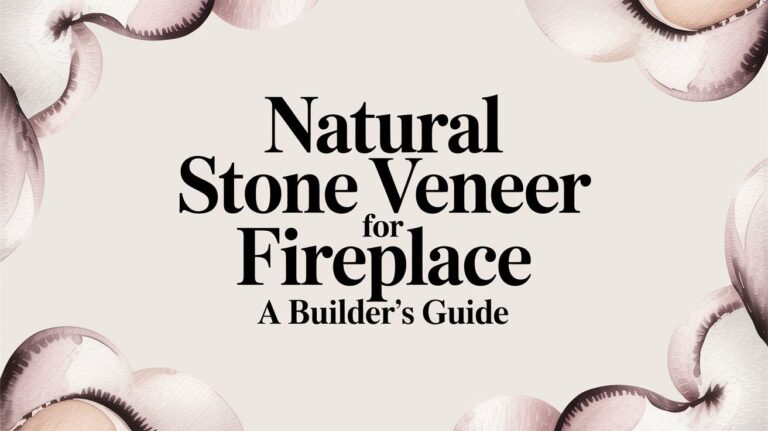Your cart is currently empty!
Wood Burning Stove with Surround
Adding a natural thin stone veneer surround to a wood-burning stove blends critical function with authentic New England style. As a non-combustible material, real stone from Stoneyard, Inc. provides the necessary heat resistance to meet safety codes while transforming a simple appliance into a permanent architectural feature. It grounds the space with the performance and heritage of materials sourced and crafted in Littleton, Massachusetts.
The Modern Hearth: Blending Style and Safety
Nothing blends raw function with authentic New England style quite like a natural thin stone veneer surround. Real stone, sourced from New England quarries and fields, provides a critical non-combustible barrier that meets stringent heat-resistance requirements. It is an authentic shield that also grounds a space with timeless, regional character.
This approach combines the rustic appeal of a traditional stone hearth with the efficiency of a modern wood-burning stove. It is a functional and aesthetic solution that turns a heating appliance into an integrated part of a home’s design.
Meeting Modern Demands
As energy costs rise, homeowners and builders are seeking efficient heating solutions that also enhance interior design. The global wood heating stove market reached approximately USD 8.3 billion in 2023 and is projected to grow to USD 16.8 billion by 2033, reflecting this demand for sustainable, design-forward heating. A stove with a proper real stone surround meets this need perfectly. You can dig deeper into this market trend over at Verified Market Research.
A properly installed natural stone surround is a vital component of a safe heating system. The stone acts as a shield, protecting adjacent walls from intense radiant heat. This is non-negotiable for meeting building codes and the stove manufacturer’s clearance requirements. A safe home environment also involves understanding home air quality to maintain a clean and healthy interior.
Integrating Authentic Materials
Choosing real New England stone from Stoneyard connects a project to a legacy of regional craftsmanship. Each piece possesses a unique texture and color profile—a direct result of local geology that manufactured or faux stone products cannot replicate.
The benefits of using 100% natural stone are clear:
- Authentic Appearance: The color is integral to the stone, not a surface coating. It will never fade, peel, or chip to reveal a different material underneath.
- Proven Durability: All Stoneyard products are Harsh Climate Approved (HCA), engineered to withstand decades of freeze-thaw cycles. This same durability ensures performance against the repeated heating and cooling of a stove.
- Timeless Style: Natural stone provides lasting value and a style that complements any architectural design, from rustic to contemporary.
Why Real Stone Veneer Is the Right Choice for Your Surround
For a wood-burning stove surround, the material must deliver safety, performance, and genuine craftsmanship. At our Littleton, MA facility, we saw real New England stone to a thickness of approximately ¾ to 1¼ inches. This specification is key to its performance and ease of use.
The reduced thickness makes the stone significantly lighter than traditional full-bed stone. While full-depth masonry can weigh over 45 pounds per square foot, our natural thin stone veneer weighs only 13-15 pounds per square foot. This weight reduction allows for installation over standard interior walls with a cement backer board, eliminating the need for costly foundational footings or structural ledges. For more information, see our guide to installing stone veneer.
Efficient Installation and a Full-Depth Appearance
The lighter weight allows masons to handle and install the stone veneer more efficiently. Despite its “thin” profile, the final appearance is robust and authentic.
We produce matching 90-degree corner pieces that wrap seamlessly around edges, achieving the solid look of a full-stone build without the associated structural requirements. This approach delivers a timeless, full-depth appearance with simplified engineering. To learn more, read about the benefits of thin stone veneer.
Wood-burning stoves are now major design features, a trend expected to make North America about 40% of the global market by 2025. The inviting atmosphere created by a real stone surround is a primary driver of this trend.
This infographic captures how a modern wood stove hearth is a marriage of style and critical safety features.
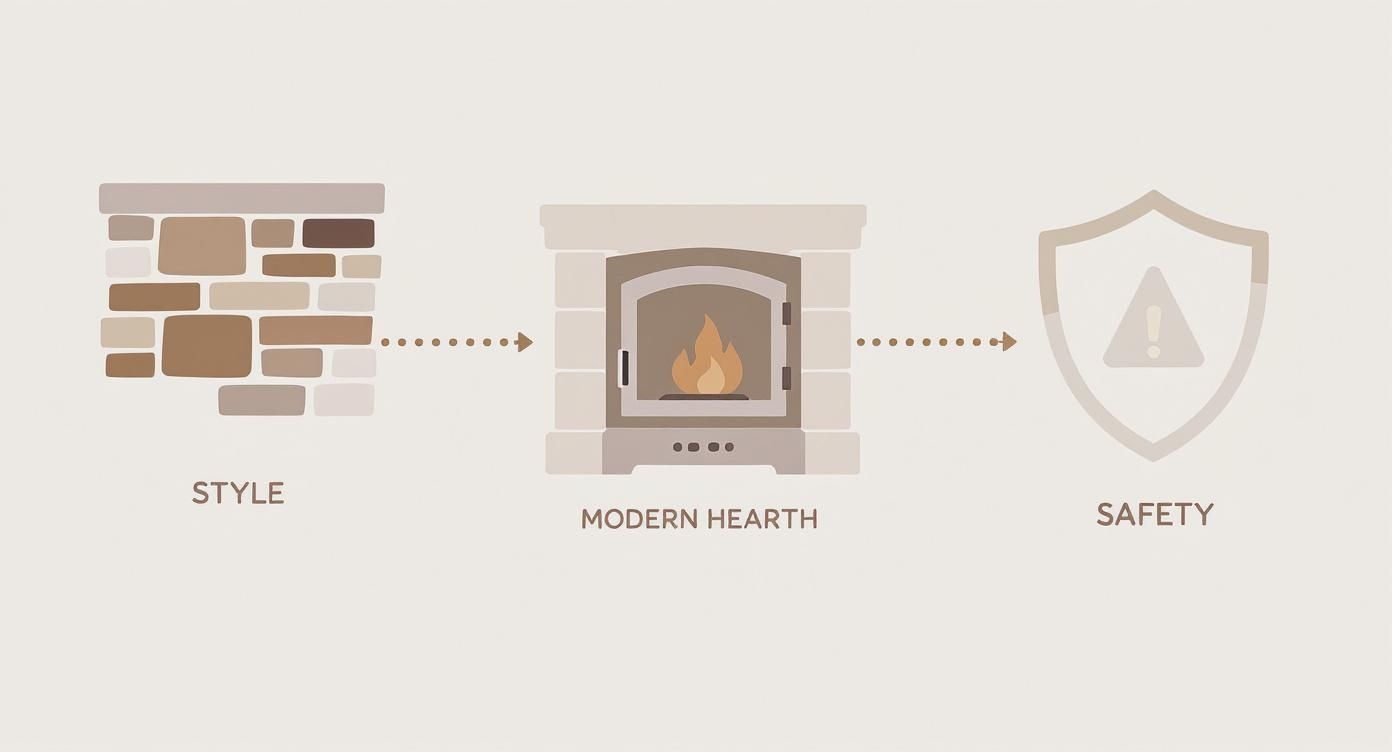
As shown, the surround material unifies the design, making it both a durable focal point and a safe, functional part of the home.
Unmatched Durability in High-Heat Environments
A stove surround is subjected to constant thermal cycling. This is where manufactured materials often fail. Products from brands such as Eldorado Stone or Cultured Stone are made from concrete with surface-applied color. Over time, intense heat can cause this artificial veneer to fade, crack, or delaminate.
Stoneyard’s real stone veneer is 100% natural New England stone. The color and texture are integral to the material, running through the entire body of each piece. This natural density ensures it will not degrade, flake, or lose its color when exposed to radiant heat.
Every product is Harsh Climate Approved (HCA), a standard developed to certify its durability against extreme freeze-thaw cycles outdoors. That same resilience makes it ideal for indoor use against the repeated heating and cooling from a stove. It is a permanent, zero-maintenance solution.
Natural Stone Veneer vs Manufactured Stone for Surrounds
When selecting a material for a high-heat application, the distinction between real stone and a cement-based product is critical. The following table compares Stoneyard’s natural stone to manufactured alternatives for stove surrounds.
| Feature | Stoneyard Natural Thin Stone Veneer | Manufactured (Faux) Stone Veneer |
|---|---|---|
| Material Composition | 100% genuine New England fieldstone or quarried stone | Concrete, aggregates, and chemical pigments |
| Heat Resistance | Excellent. Withstands extreme heat without degrading or discoloring. | Prone to fading, cracking, and delamination from repeated heat cycles. |
| Color Stability | Color is integral to the stone; it cannot fade or peel. | Color is a surface application that can fade under high heat. |
| Durability & Longevity | Permanent. Lasts for decades with minimal maintenance. | Limited lifespan; susceptible to chipping, which reveals the gray concrete base. |
| Authenticity | Each piece is unique, with natural geologic variations. | Repetitive patterns from molds create an artificial appearance. |
| Weight | Approx. 13-15 lbs/sq ft. | Often lighter, but the material is less dense and durable. |
While manufactured stone from companies like Eldorado Stone, Coronado Stone, and Cultured Stone may offer a lower initial cost, it cannot match the long-term performance and authenticity of real stone in a demanding stove surround application.
Essential Safety and Installation Guidelines
Correct installation is non-negotiable for a wood-burning stove surround. While our real New England stone is a non-combustible barrier, the entire assembly must adhere to strict safety standards to function properly and meet building codes.
The primary rule is to always follow the stove manufacturer’s specified clearances to combustibles. These minimum safe distances, typically between 12 to 36 inches, prevent radiant heat from affecting the wall structure. A natural stone surround is an ideal way to meet and exceed these requirements. For more details on adding veneer around a heat source, see our project guide on how to add thin veneer to a fireplace.
Building a Non-Combustible Foundation
Stone veneer cannot be installed directly onto drywall or wood sheathing behind a stove. The substrate must be a non-combustible material capable of withstanding high temperatures.
- Cement Backer Board: This is the standard for most interior thin stone veneer installations, providing a stable, fire-resistant surface for mortar adhesion.
- Concrete Masonry Units (CMU): If the wall is constructed from concrete blocks, stone can be applied directly to the masonry.
This layered approach ensures that even if significant heat radiates through the stone, it will not reach flammable materials within the wall. For detailed surface preparation, consult our complete stone veneer installation guide.
Mortar Selection and Sealer Precautions
The bonding agent is as important as the stone itself. Use a high-quality, polymer-modified Type S mortar formulated to provide a strong bond and accommodate thermal expansion and contraction.
A critical note: avoid applying chemical sealers to stone used for a wood-burning stove surround. While sealers may be used on exterior applications, the high heat from a stove can cause them to break down, potentially discoloring the stone or releasing harmful fumes. Our dense, low-porosity New England stone is durable enough without a sealer.
Core safety principles are universal. Following these technical details ensures your wood stove and its surround are not just a design centerpiece but a safe and lasting part of your home. For additional reference on universal safety practices, see general guides on safe installation and maintenance for wood burning stoves.
Bringing Your Wood Stove Surround Design to Life
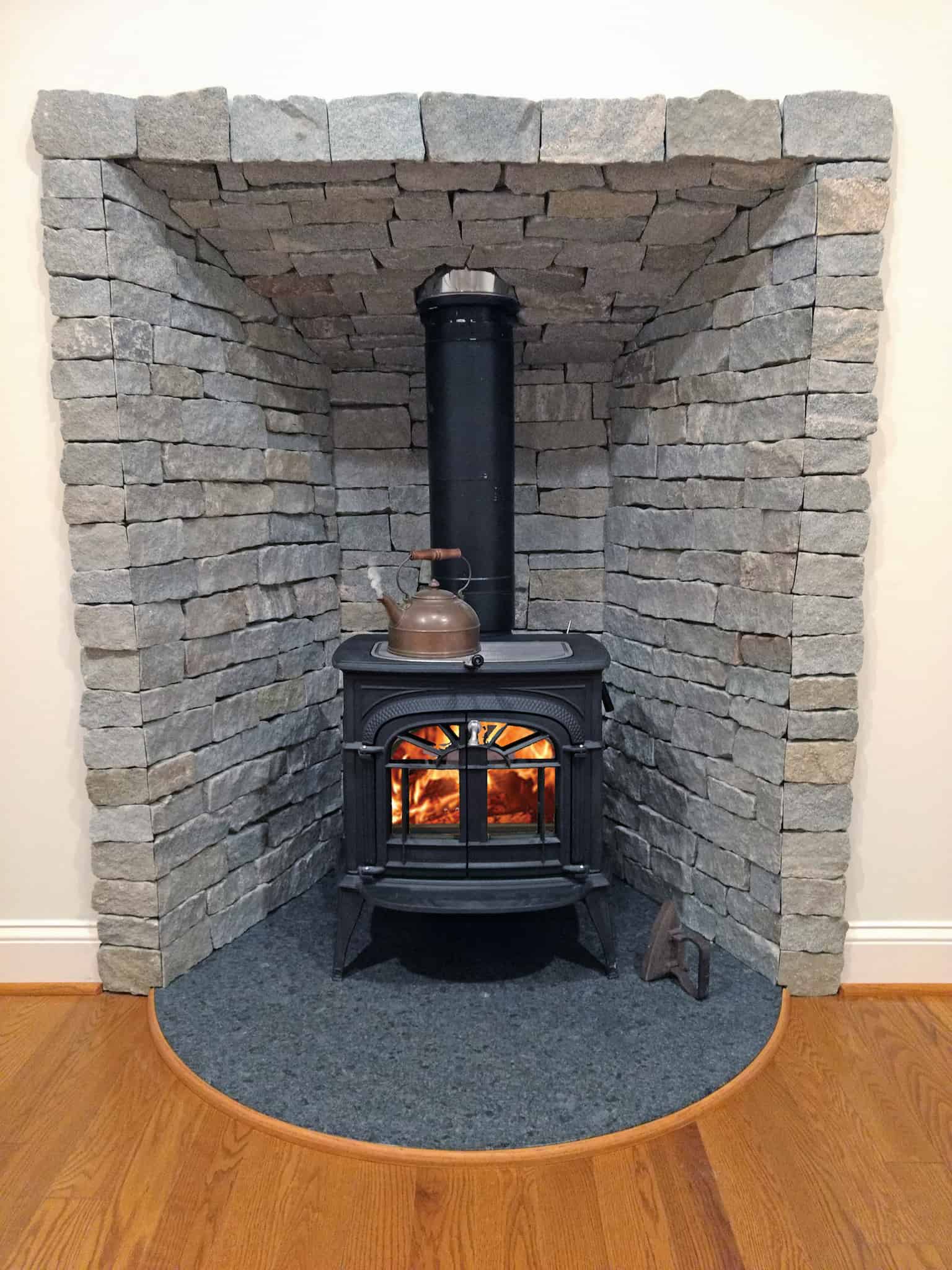
A wood burning stove surround can anchor a room’s design. Pairing the right stone shape and color blend with the interior style is key to a successful project. Natural stone is versatile enough for designs ranging from a simple hearth pad to a floor-to-ceiling feature wall.
The objective is to match the stone’s character to the home’s aesthetic. For a rustic, lodge-style interior, the irregular shapes of Mosaic or Round fieldstone are a natural fit. Extending the stone up the full wall height behind the stove creates an immersive, timeless hearth.
Pairing Stone with Architectural Style
For a contemporary look, clean lines are essential. Ledgestone, with its thin, linear strips, provides a clean, stacked appearance that works well in modern spaces. It adds texture and depth without overwhelming the room.
Similarly, Ashlar offers a rectilinear form but with taller pieces, creating a sense of scale suitable for rooms with high ceilings. A Greenwich Gray Ashlar surround, for example, creates a sophisticated, monochromatic backdrop that contrasts with the dark cast iron of the stove.
Here are a few design ideas:
- Farmhouse Aesthetic: The warm, earthy tones of Colonial Tan Mosaic deliver the classic, welcoming feel central to farmhouse design.
- Timeless New England: For a look rooted in regional heritage, Boston Blend® Square & Rectangular provides a signature mix of gray, tan, and brown in a classic, orderly pattern.
- Coastal Contemporary: The soft gray and white hues of Newport Mist Ledgestone create a light, airy backdrop suitable for coastal or modern minimalist interiors.
A well-chosen stone can unify an entire architectural theme.
Stoneyard Shape and Color Pairings for Stove Surrounds
| Architectural Style | Recommended Shape | Recommended Color Collection | Design Concept |
|---|---|---|---|
| Rustic Lodge | Mosaic or Round | Boston Blend® | Creates an organic, authentic fieldstone look with warm, earthy tones that feel timeless and cozy. |
| Modern Farmhouse | Square & Rectangular | Colonial Tan | Combines the clean lines of cut stone with the warm, inviting colors of a traditional farmhouse palette. |
| Coastal or Minimalist | Ledgestone | Newport Mist | The thin, linear shape and soft, light colors create an airy, serene backdrop that enhances natural light. |
| Industrial Loft | Ashlar | Greenwich Gray | The bold, rectilinear form and cool gray tones complement exposed brick, metal, and concrete elements. |
| Traditional Colonial | Square & Rectangular | Vineyard Granite | A classic, orderly pattern with a mix of regional gray-pink granite that echoes historic New England architecture. |
These are starting points. The versatility of natural stone allows for unique combinations tailored to any project.
Incorporating Functional Design Elements
A stone surround can be more than a backdrop. Integrating functional elements enhances the design. A raised hearth constructed from the same stone as the wall surround is a popular addition.
A raised hearth elevates the stove for easier loading and cleaning. It also provides informal seating near the warmth and can be designed with built-in nooks for firewood storage. This integration makes the entire installation feel complete. The durability of real New England stone ensures the hearth can handle the stove’s weight and daily use for generations.
The goal is to create a cohesive architectural feature. Explore our full collection of New England stone veneer colors to find the perfect match for your vision. To see completed projects and get a feel for the material, you can request a free sample.
The Unmatched Authenticity of New England Stone
Not all stone veneer is created equal. The difference between authentic, natural stone and manufactured products is significant, especially in a high-heat environment where quality is paramount.
Manufactured products, from brands like Eldorado Stone, Coronado Stone, and Cultured Stone, are cement-based veneers cast in molds and painted with surface pigments. While they may imitate the look of stone, their performance under the constant heat of a wood stove is a different matter. Intense heat cycles can cause these artificial pigments to fade, discolor, or peel, revealing the gray concrete base and compromising the investment.
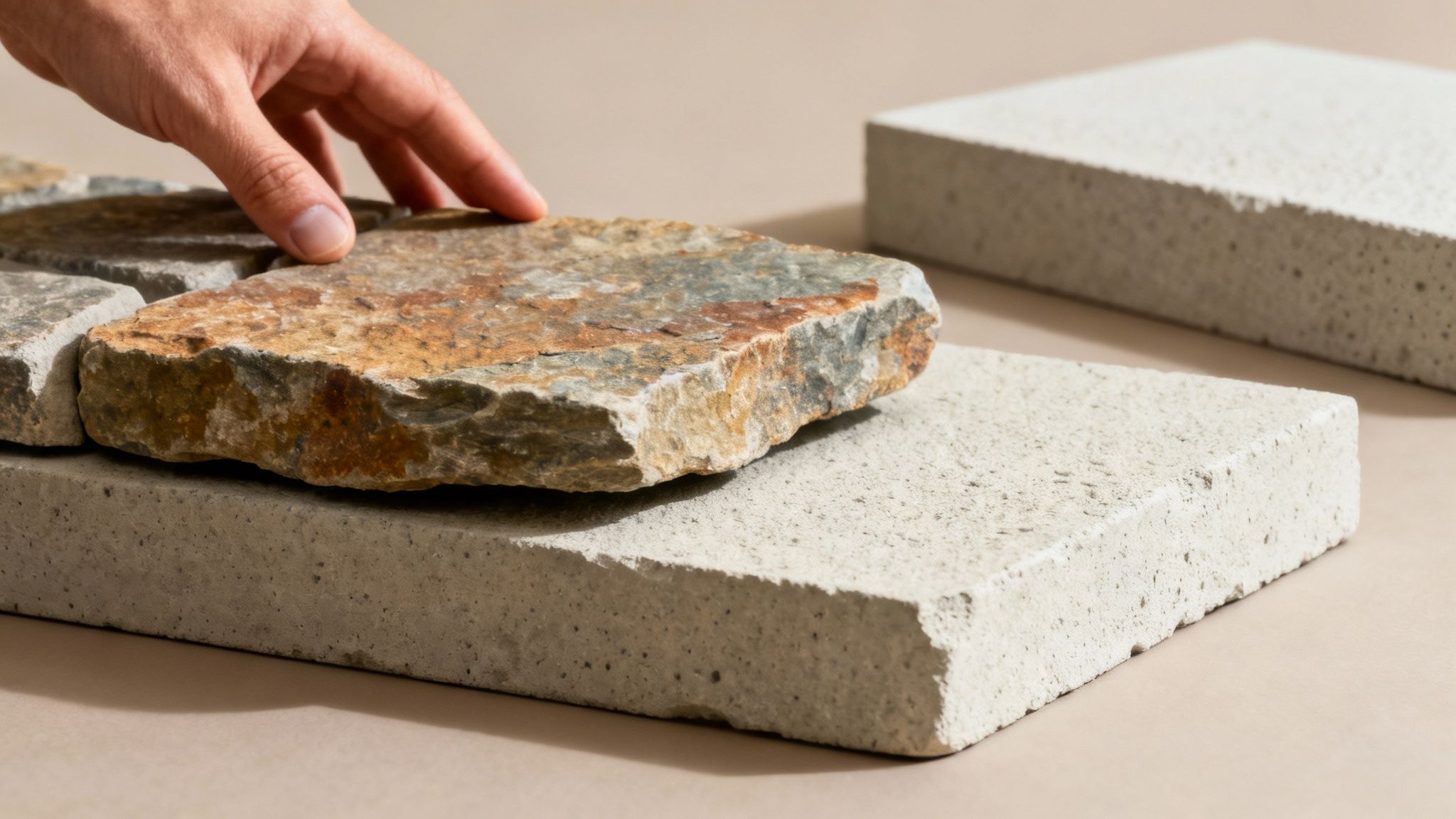
Real Stone Versus Faux Material Performance
In contrast, Stoneyard’s thin stone veneer is 100% real New England stone, sourced from local quarries and fields. The color is not a coating; it is the stone’s true color, created by regional geology. This gives it durability that manufactured products cannot match.
Natural New England stone veneer delivers multi-decade performance with minimal maintenance and no color fading. Its inherent density means it will not crack, chip, or degrade from heat exposure. Instead of wearing out, real stone develops a subtle, natural patina over the years that enhances its authentic character.
The authenticity of materials like fieldstone brings a character to a room that cannot be replicated. To learn more about this classic building material, see our guide on what is New England fieldstone.
An Investment in Permanent Craftsmanship
While the installation labor for real stone and manufactured veneer is similar, the long-term results are fundamentally different. Choosing authentic stone from Stoneyard is an investment in permanence. It is a material crafted by nature and finished by skilled hands at our Littleton, MA facility.
This commitment to authentic material ensures your wood stove surround will be safe and will add lasting, tangible value to your property. It prioritizes genuine craftsmanship, proven durability, and the timeless appeal of a material built to last for generations.
Your Next Steps From Inspiration to Installation
Choosing the right material for a wood-burning stove surround requires balancing safety, authentic style, and long-term durability. Real natural stone veneer from Stoneyard meets all three criteria. It provides a non-combustible shield that elevates a simple stove into an architectural centerpiece. It is an investment in genuine craftsmanship that performs for decades without fading or degrading.
Find Your Inspiration
Seeing completed wood stove projects provides invaluable insight into how a natural stone surround can transform a space. Our extensive photo gallery showcases numerous installations, from rustic floor-to-ceiling fieldstone hearths to clean, modern Ledgestone accent walls. Browsing these projects is an excellent way to see the versatility of our New England stone collections and generate ideas for your own design.
Natural stone’s true character is best appreciated firsthand. The subtle color variations, unique textures, and mica sparkle in a piece of Vineyard Granite are details that photos can only begin to capture.
The final step is to experience the material in your own space and lighting. Order free samples to see and feel the stone’s true color and texture where it will be installed. This is the most effective way to find the perfect match for your interior.
Explore the full Stoneyard Thin Stone Veneer Collection — real New England stone, made in the USA.
Order free samples at https://stoneyard.com/stone-samples/ or schedule a virtual showroom visit at https://stoneyard.com/contact/.
Common Questions Answered
Can I Install Natural Thin Stone Veneer Directly on Drywall?
No. Natural thin stone veneer requires a solid, non-combustible substrate such as a concrete masonry unit (CMU) wall or a cement backer board.
Drywall is a combustible material and does not meet the safety codes required for a wood burning stove with surround. Always consult the stove manufacturer’s installation manual for exact clearance requirements.
How Much Lighter is Thin Stone Veneer Compared to Full Bed Stone?
Stoneyard’s natural thin stone veneer weighs approximately 13-15 pounds per square foot. In contrast, traditional full-bed building stone can exceed 45 pounds per square foot.
This significant weight reduction allows thin veneer to be installed on standard interior walls without requiring a structural foundation or brick ledge, making it ideal for renovations.
Should I Seal the Stone on My Wood Stove Surround?
We advise against sealing stone on a stove surround. Sealants are chemical-based, and high heat can cause them to react, potentially leading to discoloration or the release of fumes.
The dense New England stone from Stoneyard is naturally resilient and does not require a sealer to maintain its appearance and durability for decades.
Explore the full Stoneyard, Inc. Thin Stone Veneer Collection — real New England stone, made in the USA. Order free samples at https://stoneyard.com/stone-samples/ or schedule a virtual showroom visit at https://stoneyard.com/contact/.


